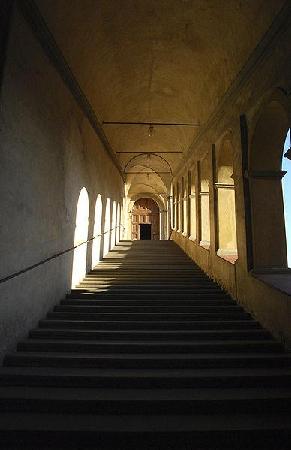This is the first of a three-part essay on monasticism by Stephanie Swee, President of the Society of St. Gregory the Great.
The Legacy of St. Benedict:
Monasticism in the Western Church
The
first question that arises regarding this topic is: What is monasticism,
anyway? Many of the sources for this paper were written at a time, just before and right after the Second Vatican
Council, when there was a lively interest in the subject. However, today it
seems there is less understanding of the vocation of the monk or nun who strives
to live the counsels of perfection, as, indeed, there is less stress even on mere
Christianity and its relevance for every person.
Dom
Hubert Van Zeller is a Benedictine monk who has written extensively on many
spiritual topics. His book, Approach to
Monasticism .is a compendium of how such a vocation is discerned and
followed. He addresses this question very simply at the outset. “The approach
to monasticism,” he writes, “is only the approach to Christianity through a
narrower door.”[1] In other words, seeking God as the end of
man’s aspirations can admit of degrees. While all Christians need to understand
that their goal is eternal happiness in the presence of God, the monk sets
himself apart from the world and takes on a life oriented directly and solely to
that goal.
Louis
Bouyer in his work, The Meaning of the
Monastic Life, gets even more specific: “If it is only God whom we seek, we
have to seek Him as a Person …the monastic call presupposes that God is someone
who has revealed himself to us by a word (and) Who has called us. And to respond to the monastic vocation is to
respond to this Person.”[2]
If we look
at the very early Church we will see that the first Christians took this pursuit
of union with God seriously enough that it informed the whole of life. Simply to
follow Christ then could be as all-consuming as living a religious vocation is today.
In fact, many Christians regarded their
faith as reason to joyfully lay down
their lives in witness to Christ. It is interesting to note that it was after
the great Roman persecutions ended that certain Christians withdrew to practice
asceticism. Indeed, if one faces the
possibility of death for Christ, one need not look for a higher way to serve
Him. Once Christianity became respectable, however, many writers note that “the
monk came to replace the martyr as hero. Whereas the martyr died for Christ;
the monk lives for Him.”[3]
Some
writers have pushed the beginnings of monasticism back as far as the Decian persecutions
in the mid-third century, but “the great Christian historian Eusebius makes no
mention of it in his history.” [4]
There is actually little written about the life of monks before 330 A.D., even
though by the time Athanasius died in 373 A.D., “the movement had witnessed
extraordinary growth.”[5]
The
Introduction to The Rule of St. Benedict dismisses the many theories that early
monasticism grew out of pre-Christian sects. Rather than the philosophical asceticism of
the pagan Greeks, “The ascetic tradition in Christianity … can … be traced directly
back to the New Testament. Of particular importance was the tradition of
virginity and celibacy that was grounded in the example and teaching of Jesus.”[6] In
fact, the belief grew quickly that monasticism was a logical outgrowth of
Christian life. “Just as baptism was held to forgive sins, so the monastic
profession (of vows) came to be held to forgive sins.”[7]
It is
likely that cenobitic monasticism – i.e., monks living in community – was a
variation of life of the Eastern
Church’s early Fathers of the Desert, eremites who lived in solitude except when
they came together occasionally for prayer, reading of Scripture and spiritual
discussions. That the desert was the
preferred locale for the anachoresis,
or “retirement from the world,” is a living of the passage in St. Matthew that tells us that”
Jesus withdrew to the desert place by himself.”
St.
Anthony of the Desert, generally held to be the “father of the eremitic life,”
was born about 250 A.D. His turbulent and colorful path to holiness was
chronicled by St. Athanasius. He is said to have been assailed by the devil
spiritually and physically with great vigor, but eventually to have triumphed
over these trials. After some time alone, he was followed to the wilderness by
others who desired to take on the same penitential life. At
first, these aspirants had to beat down his door, but eventually Anthony emerged
and agreed to teach them how to live apart from the world as he did. He performed many miracles and became the de facto head of the scores of men who
sought to find only God in the desert.[8]
After
Anthony died, however, some Christian writers began to warn of the dangers in
such a solitary life and, even in the Eastern Church, cenobitic monasticism
began to grow. Its first famous proponent was Pachomius, who, like Anthony,
drew many to himself, but,, unlike his predecessor, succeeded in “shifting
attention … away from himself and to the community as the locus of the Spirit.
His followers became a fellowship of brothers, a koinonia.”[9]
Later St. Basil also began to establish communities of monks in the East.
[1]
Van Zeller, Dom Hubert, Approach to
Monasticism. New York: Sheed and Ward,
1960, p. 8.
[2]
Bouyer, Louis, The Meaning of the
Monastic Life. London: Burns and Oates, 1933, p. 8
[3]
RB: 1980: The Rule of St. Benedict,
Timothy Fry, O.S.B., editor. Collegeville, Minnesota: The Liturgical Press,
1980, p. 14.
[4]
RB: 1980,, p. 3.
[5]
RB.1908, p. 4.
[6]
RB 1980, p. 3
[7]
RB 1980, p. 15
[8]
RB 1980, pp. 18-20.
[9]
RB 1980, pp. 24-25.

No comments:
Post a Comment